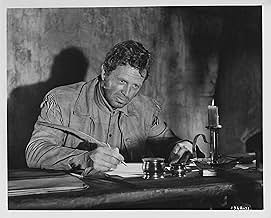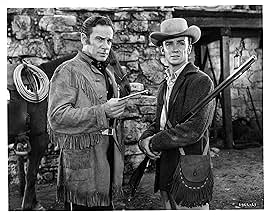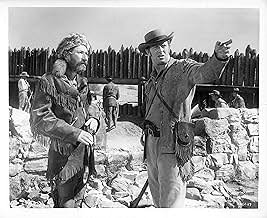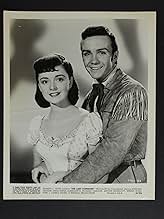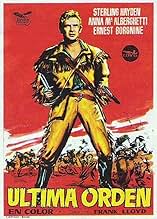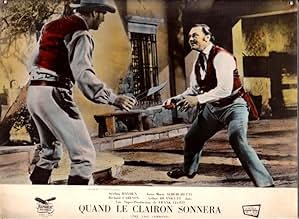IMDb-BEWERTUNG
6,3/10
1040
IHRE BEWERTUNG
Füge eine Handlung in deiner Sprache hinzuModerate Jim Bowie leads rebellious Texicans--and Davy Crockett--in a last-ditch stand against his old friend, Santa Ana.Moderate Jim Bowie leads rebellious Texicans--and Davy Crockett--in a last-ditch stand against his old friend, Santa Ana.Moderate Jim Bowie leads rebellious Texicans--and Davy Crockett--in a last-ditch stand against his old friend, Santa Ana.
- Regie
- Drehbuch
- Hauptbesetzung
Abdullah Abbas
- Townsman
- (Nicht genannt)
Rico Alaniz
- Tomas
- (Nicht genannt)
Empfohlene Bewertungen
'The Last Command' is a film with a better backstory than the film itself! First batted around Republic Pictures as a potential vehicle for John Wayne, the production was put on the back burner when Wayne decided he wanted total creative control, and decided to produce and direct his own version, with a budget Republic couldn't match.
Republic DID, however, have an arsenal of talent available, and a shooting script, and eventually brought in veteran director Frank Lloyd, who had just come off a ten-year hiatus with 'The Shanghai Story', in 1954. Sterling Hayden, fresh from the cult classic 'Johnny Guitar', and a featured role in Fox's lavish 'Prince Valiant', signed to play Jim Bowie ("I needed the money to refit my boat," he joked). Richard Carlson, whose 'Creature from the Black Lagoon' had just been released by Universal (becoming a big hit) was tapped to play Alamo commander William Barret Travis. Ernest Borgnine, whose 'Marty' was garnering rave reviews (and would earn him an Oscar) took on the showy supporting role of Bowie adversary/friend Mike Radin and starlet Anna Maria Alberghetti, in her first non-singing role, became the female lead. Two veteran character actors rounded out the major cast: J. Carrol Naish, as a sympathetic yet decisive Santa Anna, and, in an offbeat but inspired casting move, bearded Arthur Hunnicutt as a rustic Davy Crockett (who would very nearly steal the film!).
The production was very modestly budgeted, so much so that the number of extras serving as the Mexican army was limited, but director Lloyd and cinematographer Jack Marta were old hands at making more out of less, and with some judicious editing by Tony Martinelli, the illusion of thousands of Mexican soldiers was achieved. Set design was minimal, as well, and the famous 'look' of the church/fortress was often achieved through mat paintings.
Scored by the legendary Max Steiner, with a theme sung by Gordon MacRae, 'The Last Command' seemed to teeter at the edge between 'B' movie and 'A' status; ultimately, the pedestrian script, by Sy Bartlett and Warren Duff, did the movie in, as there was too much time spent on an unnecessary love triangle, which slowed much of the film to a crawl. Despite an unforgettable final battle, audiences avoided the film, and it quickly faded from sight.
Unfortunately, John Wayne didn't learn from 'The Last Command', and he added a love story to his 'Alamo', with the same lethargic result; Crockett's explosive demise (historically inaccurate, but rousing!) must have impressed him, as well, as he staged an even bigger version of it in his film.
'The Last Command' is a curio, but is enjoyable, for the most part, and the spectacular final assault makes it a must for any action fan's collection!
Republic DID, however, have an arsenal of talent available, and a shooting script, and eventually brought in veteran director Frank Lloyd, who had just come off a ten-year hiatus with 'The Shanghai Story', in 1954. Sterling Hayden, fresh from the cult classic 'Johnny Guitar', and a featured role in Fox's lavish 'Prince Valiant', signed to play Jim Bowie ("I needed the money to refit my boat," he joked). Richard Carlson, whose 'Creature from the Black Lagoon' had just been released by Universal (becoming a big hit) was tapped to play Alamo commander William Barret Travis. Ernest Borgnine, whose 'Marty' was garnering rave reviews (and would earn him an Oscar) took on the showy supporting role of Bowie adversary/friend Mike Radin and starlet Anna Maria Alberghetti, in her first non-singing role, became the female lead. Two veteran character actors rounded out the major cast: J. Carrol Naish, as a sympathetic yet decisive Santa Anna, and, in an offbeat but inspired casting move, bearded Arthur Hunnicutt as a rustic Davy Crockett (who would very nearly steal the film!).
The production was very modestly budgeted, so much so that the number of extras serving as the Mexican army was limited, but director Lloyd and cinematographer Jack Marta were old hands at making more out of less, and with some judicious editing by Tony Martinelli, the illusion of thousands of Mexican soldiers was achieved. Set design was minimal, as well, and the famous 'look' of the church/fortress was often achieved through mat paintings.
Scored by the legendary Max Steiner, with a theme sung by Gordon MacRae, 'The Last Command' seemed to teeter at the edge between 'B' movie and 'A' status; ultimately, the pedestrian script, by Sy Bartlett and Warren Duff, did the movie in, as there was too much time spent on an unnecessary love triangle, which slowed much of the film to a crawl. Despite an unforgettable final battle, audiences avoided the film, and it quickly faded from sight.
Unfortunately, John Wayne didn't learn from 'The Last Command', and he added a love story to his 'Alamo', with the same lethargic result; Crockett's explosive demise (historically inaccurate, but rousing!) must have impressed him, as well, as he staged an even bigger version of it in his film.
'The Last Command' is a curio, but is enjoyable, for the most part, and the spectacular final assault makes it a must for any action fan's collection!
Made in spite by Yates, well shot and mounted, replete with an excellent cast, 'The Last Command' still remains good value even if it rather pales besides Wayne's grandiose epic of just a few years later. The much underrated Hayden is superb as "big Jim Bowie" and Hunnicutt equally as good as Davy Crockett. Hayden has the ability to appear gentle, naive, rugged and brusque all at once - something few other actors, with perhaps the exception of Spencer Tracy, managed. Unfortunately Crockett and his 29 men don't appear until some way in. With only Hayden's latent dynamism really keeping things afloat, the first half an hour of the film is rather talkative in exposition, and it drags somewhat. Consuela de Quesada (Anna Marie Alberghetti) is a limp romantic foil to Bowie - I for one would be happy to have seen her written out and the structure tightened through her absence. Ernest Borgnine plays his small role with gusto - his confrontation with Bowie a standout scene in a film full of fighting, although his later genial acceptance of Bowie's superiority as a man is perhaps emphasised by the script too much for comfort.
Steiner's music (and especially the superb title song) goes a long way in making events move smoothly towards the climax. For it's the Alamo Battle the bums on seats will have come to see, and here it is done well (although again not *as* well as Wayne would manage with considerable more time and resources later (although any comparison isn't too much to the present film's detriment).
In short this is well worth seeing, and it provides a contemporarily staged contrast to the better-known epic which was to follow. I'd still like to see an historically accurate account of the events at the mission, though...
Steiner's music (and especially the superb title song) goes a long way in making events move smoothly towards the climax. For it's the Alamo Battle the bums on seats will have come to see, and here it is done well (although again not *as* well as Wayne would manage with considerable more time and resources later (although any comparison isn't too much to the present film's detriment).
In short this is well worth seeing, and it provides a contemporarily staged contrast to the better-known epic which was to follow. I'd still like to see an historically accurate account of the events at the mission, though...
In the habitual group of various characters we find the starring Jim Bowie of ¨Bowie knife¨ fame (Sterling Hayden) who held command until stricken with typhoid-pneumonia , Colonel William Barret Travis (Richard Carlson) , commander of the small garrison of some 180 men and Davy Crockett of Tenesse (Arthut Hunnicutt) who had arrived with a dozen volunteers . They're guarding El Alamo against a Mexican militia commanded by General Antonio Lopez De Santa Anna , President of Mexico (J. Carroll Nash) . They're featured in more realistic roles than successive films , though here predominates the melodrama . It's a spectacular film hampered by a tiring screenplay and including Max Steiner's excellent score with a title song by Gordon McRae . The motion picture well produced by Republic's founder , Herbert J. Yates, was professionally directed by Frank Lloyd . Subsequently , five years later , John Wayne made his own retelling : ¨El Álamo¨ (1960) , utilizing a lot of the still-standing sets that were used in this movie .
The film is rightly based on historic events , these are the followings : On 23 February 1836 a army of 5000 entered San Antonio. When Santa Anna demanded the surrender, William Travis answered with a cannon shot. So began thirteen day siege that ended with the Mexicans storming the fortress, the defenders, to a man , fought on until death .With bugles sounding the ¨deguello¨(signifying no quarter to the defenders) attacked the adobe walls from all four sides and broke through. Travis was shot dead over his cannon . Crockett using his rifle as a club, fell under a swarm of the enemy . Bowie fought to the last from his sickbead. The Mexicans had won a Pyrrhic victory suffering more than 1500 casualties. Forty six days after the fall ,less than 800 Texans and American volunteers led by General San Houston defeated Santa Anna and his army of 1300 at San Jacinto. Shouting ¨Remember the Alamo¨ Houston's men completely routed the Mexicans in a matter of minutes, killing 630 while losing only 8. Santa Anna was captured, and the Republic of Texas was born.
The film is rightly based on historic events , these are the followings : On 23 February 1836 a army of 5000 entered San Antonio. When Santa Anna demanded the surrender, William Travis answered with a cannon shot. So began thirteen day siege that ended with the Mexicans storming the fortress, the defenders, to a man , fought on until death .With bugles sounding the ¨deguello¨(signifying no quarter to the defenders) attacked the adobe walls from all four sides and broke through. Travis was shot dead over his cannon . Crockett using his rifle as a club, fell under a swarm of the enemy . Bowie fought to the last from his sickbead. The Mexicans had won a Pyrrhic victory suffering more than 1500 casualties. Forty six days after the fall ,less than 800 Texans and American volunteers led by General San Houston defeated Santa Anna and his army of 1300 at San Jacinto. Shouting ¨Remember the Alamo¨ Houston's men completely routed the Mexicans in a matter of minutes, killing 630 while losing only 8. Santa Anna was captured, and the Republic of Texas was born.
Frank Lloyd's career stretched back to the silent era--he was a major director and made films for the top studios in Hollywood. Winding up at a B studio like Republic would seem to be a step down the career ladder, but this film is actually one of Lloyd's best and one of the best to ever come out of Republic.
The studio didn't often get the services of directors of the calibre of Frank Lloyd--although John Ford and Fritz Lang had occasionally made films there--and it spared no expense on this one. The subject matter demanded a big budget, and Republic didn't stint. Thousands of extras, big sets, spectacular action scenes, robust performances--all combined to make a first-rate action picture. Sterling Hayden makes a good Jim Bowie, the always underrated Arthur Hunnicutt personifies Davy Crockett, and the cast is filled with familiar character actors--Roy Roberts, Slim Pickens, John Russell, Jim Davis--who contribute much to the overall atmosphere of the film. The setpiece of the movie, though, is the final siege of the Alamo itself, and it is spectacular. It compares well to the John Wayne version made five years later, and ranks right up there with the final battle scene in 1964's "Zulu"--expertly edited with top-notch stunt-work and special effects. Very highly recommended.
The studio didn't often get the services of directors of the calibre of Frank Lloyd--although John Ford and Fritz Lang had occasionally made films there--and it spared no expense on this one. The subject matter demanded a big budget, and Republic didn't stint. Thousands of extras, big sets, spectacular action scenes, robust performances--all combined to make a first-rate action picture. Sterling Hayden makes a good Jim Bowie, the always underrated Arthur Hunnicutt personifies Davy Crockett, and the cast is filled with familiar character actors--Roy Roberts, Slim Pickens, John Russell, Jim Davis--who contribute much to the overall atmosphere of the film. The setpiece of the movie, though, is the final siege of the Alamo itself, and it is spectacular. It compares well to the John Wayne version made five years later, and ranks right up there with the final battle scene in 1964's "Zulu"--expertly edited with top-notch stunt-work and special effects. Very highly recommended.
While not totally historically accurate, this film is at least as accurate, if not more so, than most of the other Alamo epics. There are points in all the films that are arguable, if not totally wrong. However, I have researched most of the Alamo films and find this one more accurate from the viewpoint of the depiction of the Mexicans in the Alamo and some of the more personal facts about Bowie. For example, the death of his wife sometime before the start of the battle. No Alamo film is totally accurate, including the newly made Alamo with Billy Bob Thornton and Dennis Quaid. The important thing is that this is the story of brave men fighting a battle they cannot win against a far larger army. The spirit of the story is the important thing in this case.
Wusstest du schon
- WissenswertesThe melody to "The Ballad of Rock Ridge" from the western spoof Der wilde wilde Westen (1974) is taken almost note for note from this film's "Jim Bowie", sung by Gordon MacRae. Coincidentally, Slim Pickens appears in both films.
- PatzerWhen Gen. Santa Ana's cavalry charges toward the Alamo, the tire tracks of the camera truck are visible in front of the horses.
- VerbindungenFeatured in That's Action (1977)
- SoundtracksJim Bowie
by Sidney Clare and Max Steiner
Sung by Gordon MacRae
A Capitol Recording Artist
Arranged by Van Alexander (uncredited)
Top-Auswahl
Melde dich zum Bewerten an und greife auf die Watchlist für personalisierte Empfehlungen zu.
- How long is The Last Command?Powered by Alexa
Details
Box Office
- Budget
- 2.193.939 $ (geschätzt)
- Laufzeit
- 1 Std. 45 Min.(105 min)
- Seitenverhältnis
- 1.66 : 1
Zu dieser Seite beitragen
Bearbeitung vorschlagen oder fehlenden Inhalt hinzufügen

